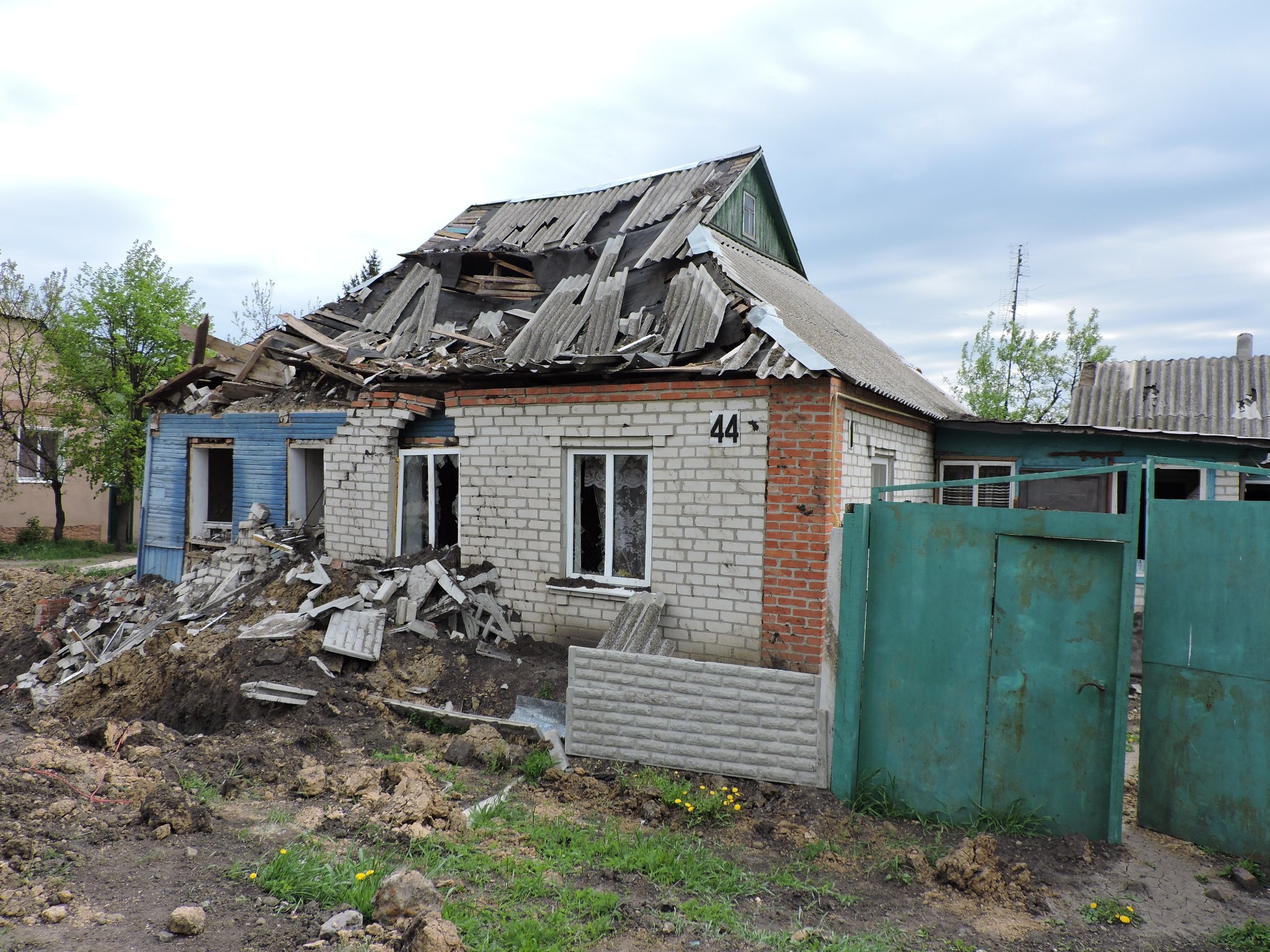By Serhiy Petrov
There were very few muscovite strikes on the city today, all directed to the northern outskirts. The situation is worse in the suburban towns north of Kharkiv, particularly in the villages that have been liberated. The muscovites are now defending themselves in battles to the north and to the east of Kharkiv. Fighting continues in the southeast as well.
The amount of muscovite attacks on Kharkiv is so small that you can literally count them on the fingers of one hand. In addition, it’s often difficult to tell which areas have been struck, whether it’s the northern suburbs, Pivnichna Saltivka, Selyshche Zhukovskoho, or somewhere near Pyatykhatky. On Sunday night they struck Sokilnyky, near the World War II Memorial in Lisopark. Way to celebrate Victory Day.
The northern outskirts of Kharkiv, including Slatyny, Prudyanka, the outskirts of Derhachi, Ruska Lozova, Ruski Tyshky, Cherkaski Tyshky, and Tsyrkuny, are being shelled constantly. Obviously, all the shelling and all the sounds have moved to that area, and their echoes can be heard in Kharkiv. There was no information about strikes in Bohodukhiv or Zolochiv for the day. (This is information from the regional administration for the 24 hours from the morning until the following morning. There were strikes on May 8. The village of Rai-Olenivka in the Pisochyn Hromada, located near the village of Pisochyn, was also shelled. The muscovites also fired on the Chuhuiv district.

Fighting continues to the north of the city. The ruscists are defending themselves and trying to counterattack from time to time. Our counteroffensive to the northeast of the city continues. The 227th Territorial Defense Battalion of the Armed Forces of Ukraine announced the liberation of four villages, including Verkhniy Saltiv, Zamulivka, Bayrak, and Rubizhne. This was also confirmed by volunteer Roman Donik. I will note that there was no official information from the General Staff about the liberation of these villages yet. I am very worried about the state of the history and archeology museum-preserve “Verkhniy Saltiv” and the survival of its unique collection. After all, there is the possibility that the muscovites looted it and took part of it to moscovia. As for the village of Rubizhne, not to be confused with the city in the Luhansk region, it is a great place. I’ve been there many times as a child, and I’d say that from those heights you can keep the Vovchansk station on the Belhorod-Kupyansk railway line in the line of fire and hold back the supply of occupation forces directly from Belhorod.
The city is quiet, and very few people are on the streets. Due to shortage of fuel there are very few cars on the roads. The city is living its wartime life, the situation is stable. The silence is stressful for many—because of the fear that it may end. The amount of strikes doesn’t come close to what it was a week to a week and a half ago (and even then the situation was already fairly acceptable).
But it’s too early to return to Kharkiv. First, because of the dearth of fuel across the country, and second, the situation needs to stabilize to where there are no outbreaks of ruscist activity. Besides, there’s no work or public transportation. Visiting to pick up things or board up broken windows is an acceptable option, but staying in the city probably isn’t. Unless of course you plan to volunteer or otherwise help defend Kharkiv and keep it functioning.
Terekhov, Kharkiv’s mayor, wants to quickly rename some streets and has decided to let the people determine the changes. (That’s his argument to the professionals: historians and toponymic professionals.) Meanwhile, most of the options being considered are either devoid of historical basis or based on a local identity rather than a national one. The names being proposed are Heroiv Kharkova (Heroes of Kharkiv), Kyivskyi Shlyakh (Kyiv Way), Zakhysnykiv Ukrainy (Defenders of Ukraine), Kharkivskyi Shlyakh (Kharkiv Way). The last one is winning the “vote” on social networks. Meanwhile, the Kharkiv Toponymic Group and many other activists suggest names like Chuhuivskyi Shlyakh (a historical name) or Iziumskyi Shlyakh. As I predicted, the city government will try as much as possible to make the renaming process a formality and do all it can to promote a local identity (so that they wouldn’t have to change street names when someday their “brothers” come, and power changes hands). As Terekhov’s predecessor Kernes once said, “This is bullshit. Let’s start over.”
The Kharkiv Regional Council held a meeting. Ninety-eight of the 120 deputies joined online. The council voted in support of a statement condemning moscovia’s military aggression, declaring that the entire territory of the Kharkiv region is part of Ukraine, calling on people in the occupied territories to ignore any of the pseudo-elections being held there or any regulatory actions by the Russian Federation’s occupying administrations, and voicing support of the territorial integrity and independence of Ukraine. In addition, 28 people left the Opposition Platform-For Life fraction of the Kharkiv Regional Council. Hennadiy Matsehora, the mayor collaborator from Kupyansk, was the only one who did not leave. Twelve of the 28 people formed the parliamentary group “Vidnovlennya Ukrainy.” Thank you, but Kharkiv, the Kharkiv region, and Ukraine are better off being restored without the involvement of former OPZZhytsts (translator: members of the Opposition Platform-For Life party). Moreover, they all need to be checked by SBU (Security Service of Ukraine) for having any contact with moscovia.
There were no Victory Day parades in Kharkiv. There were no celebrations either, outside of a few individual “celebration” attempts. There’s really no point in celebrating the day of Kolyma’s victory over Buchenwald. One occupier was replaced by another, and one set of concentration camps by another. After all, moscovia occupied Ukraine from 1920, following the destruction of the People’s Republic of Ukraine, through 1991. One should celebrate the day the war in Europe ended and the memory of those who gave their lives in the fight with Nazism. In Europe, that’s May 8. Only the soviets decided to celebrate “May 9,” just to be different from everyone else.
Bodies of two women killed by an explosion were found in Tsyrkuny as the territory near the bridge was being cleared of mines. It is dangerous to return to the newly liberated villages because of all the mines the muscovites left behind, often inside homes. It’s also dangerous because of the constant shelling of these areas. Two sappers were injured to varying degrees of severity when they were clearing one of the liberated settlements of the Kharkiv region of mines.
I visited Mala Rohan. There are multiple destroyed or partially destroyed houses here. There are many houses with holes in the roofs made by shell fragments. The school is missing almost all its windows, and there are signs of a fire. This is just an ordinary village that speaks in the Slobozhansk dialect. The purpose of the trip with fellow journalists was to interview locals. The muscovites entered here on March 1, the 6th day of the wide-scale invasion. Locals say they hid from the ruscists, did not communicate with them, and survived on their own supplies. However, there were some desperate people who went across the fields to Kharkiv to buy food. In addition to the case of rape I wrote about, some residents are aware of at least one case of a local resident being killed. During the occupation, there were about 120-150 inhabitants, but people are gradually returning. There are now about 500 residents out of 2,500 that lived here before the invasion. Some people help their neighbors by delivering humanitarian aid. They are happy to have been liberated by the Ukrainian troops and look forward to the future with optimism.
Fighting is ongoing in the Slovyansk and Barvinkove directions; Barvinkove is being shelled.
Victory Day, the Immortal Unit, and other elements of Victory Day were celebrated in the temporarily occupied territories of the Kharkiv region today. Such parades in Kupyansk were joined by the so-called “head of the temporary administration of Kupyansk,” collaborator Hennady Matsehora, and a similar “head” of the Kozacha Lopan, Vitaliy Ganchev, whom the occupiers proclaimed “head of the provisional administration of the liberated territories of the Kharkiv region.” Both justified moscovia’s war against Ukraine and appear to have said enough to earn life sentences.
There were similar events in Vovchansk. Very few people gathered. Iryna Ukhanyova, head of the Vovchansk District Court, who is being suspected of treason, became the collaborator there.
By the way, Dmytro Sviatash, the former people’s deputy from Partiya Rehioniv who was elected in the 170th electoral district, was supposed to become the muscovite Gauleiter of Kharkiv. We know that the Moscow part of Saltivka (Pivnichna Saltivka is a Kyiv part), suffered less than Pivnichna Saltivka. But the scale of damage and destruction is still large. He was elected to represent my district, the destroyed part, where I lived until the beginning of March 2022. On one hand, that Saltivka was destroyed the most could be explained by the fact that the muscovites got closer to Kharkiv on that side, but on the other it seems like Svyatash okayed it. Svyatash is under investigation; he is hiding in moscovia. His father, Volodymyr Sviatash, a deputy of the Kharkiv Regional Council from Kernes’ block “Uspishnyi Kharkiv” is also hiding in moscovia, like his son. So here is a question for the party and for the head of the fraction in the Regional Council, Kirill Kernes, as well as for Mr. Terekhov: When will this person be expelled from the fraction and his mandate revoked in line with the current legislation? This is a very important question in my opinion.
The ruscists are withdrawing a portion of the troops from the occupied territory of the Borivka Hromada to redirect them to Kupyansk, particularly from the village of Borova and the village of Bohuslavka of the Borivka Homada. The occupiers catch chickens, ducks, and geese on the streets and either take away pigs or food products from the locals or offer something in exchange. There seem to be some “difficulties” with supplies. It could also be simply thirst for looting. In propaganda videos from the villages of the Borivka Hromada, the muscovites are obviously hiding areas with destroyed houses.
There’s heavy fighting near Lyman, on the shores of Siverskyi Donets. The muscovites wanted to cross it using pontoon bridges, but our military stopped these attempts. Fighting continues on the outskirts of Rubizhne and near Sievierodonetsk. It is impossible to pull people out from under the rubble in Bilohorivka. It’s also impossible to clear the rubble in Shypilove, where 11 people were hiding in a basement. Police officers who tried to do it were shot at by the ruscists. One of the officers was wounded.
There’s constant shelling of towns and villages in the Luhansk and Donetsk regions. There’s a lot of destruction. There are many dead and wounded. Fighting continues outside Popasna on the new front lines, in the area of Avdiivka and Maryinka, Velyka Novosilka, in the Donetsk region, as well as Huliaipole and Orikhiv, in the Zaporizhzhya region. Huliaipole and Orikhiv, as well as nearby villages, are being shelled.
There were also Victory Day celebrations in the occupied territories of southern Ukraine. They say the biggest ever St. George’s rag was stretched in Kherson. However, nobody showed up except the people who held it, many of whom were driven in to create a crowd. This is all the muscovite propagandists managed to do. Although they tried to filmed it in a way that would give the impression that there were many people there. Shoot from above, and suddenly all the propaganda dissipates.
In Melitopol, a Gauleiter (so-called “head of the interim administration”) of the Zaporizhzhya region was announced. Yevhen Balytsky, a former people’s deputy and now a deputy of the Zaporizhzhya regional council from the “opposition” was appointed to this position. By the way, the Gauleiter-collaborator of Melitopol, Halyna Danylchenko, was an assistant when Balytsky was a People’s Deputy.
A special Pulitzer Prize nomination was awarded to all Ukrainian journalists for their coverage of the war. I am not going to try to look like I’m part of that group, as many journalists have done much more than me and have been in much more dangerous places than me and our team of documentarians. But we have also made and will continue to make efforts to shine a light on the consequences of the destruction and damage to the civilian infrastructure of Kharkiv and the Kharkiv region. We’re not doing it for prizes, awards, or anything else other than two things. First, the muscovites should be held responsible, and second, someone has to monitor and document the war crimes. Documentation differs from traditional journalistic work, because it’s not about making a beautiful photo; it’s about documenting a crime scene. It’s not about beauty; it’s about making things visible.
US President Joe Biden has signed a lend-lease law for Ukraine. It has simplified the procedure for providing the equipment, but its funding, through other laws, still has to be approved by Congress. It is important to speed things up this stage, so that we can receive as much of the necessary assistance as we need at the frontline. This cannot be done without pressure by our diaspora in the United States.
In Warsaw, muscovite Ambassador Sergei Andreev was doused with artificial blood and prevented from laying flowers at a memorial to Soviet soldiers. The action was organized by Ukrainian journalist Iryna Zemlyana, who was later detained by police.
Now for something funny. The aviation part of the (Victory Day) parade in moscovia was officially canceled due to “weather,” although the weather was normal. Rumor has it, the “doomsday plane” IL-80 was out of order and simply could not fly. Similarly, the aviation parade was canceled in many other cities of moscovia. Somewhere, a tank from the 1920s or ‘30s was shown as “the latest in tank forces.” (I wonder how that thing still manages to move. Maybe it has foreign engines.) At the parade in Volhohrad, they flew a “Kukuruznik” PO-2. Where did all the aviation and the equipment go? Did it drown, like the ship?
Today’s Darwin Award goes to:
- Yulia Tymoshenko, who was walking around the ruined Pivnichna Saltivka in high heels, a skirt, a bulletproof vest, but without a helmet. She was walking in her high heels on the broken asphalt. It looks so unreal, it’s hard to describe. With the frontline being 5 or 6 kilometers away, even a mine launcher can hit you. But no helmet seems to fit the braid that gets longer every day. This grandmother wants to look like a 20-year-old… The Darwin Award is clearly shared by her bodyguards and those who drove her there.
- The muscovites from Berdsk, Novosybirsk region, where an armored personnel carrier caught on fire during a World War II reenactment.
Let us believe in our defenders and the Armed Forces of Ukraine! Let us support volunteers, medics, and rescuers. And let us get closer to our victory!




